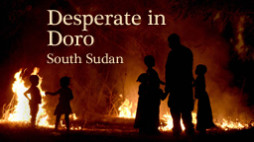
South Sudan continues to struggle for peace and autonomy after splitting from the North in 2011. With tribes displaced, they … Continue reading

South Sudan continues to struggle for peace and autonomy after splitting from the North in 2011. With tribes displaced, they … Continue reading

Women make up 50% of the coffee labor in Kenya, though few see their hard work reflected in their monthly … Continue reading
Though the borders separating North and South Sudan were established by the British in 1953, they weren't formally recognized until July 9, 2011, when South Sudan voted to secede from the predominantly Arab North. The resulting two countries left thousands of marginalized tribes living along a contentious border who, despite their proximity, sided more ethnically and politically with the South. In September, 2011, villages in the Upper Nile became the targets of North Sudan's Antonov bombers, as directed by Khartoum, who today continues to push these marginalized tribes south and--through terror--squelch a perceived threat to the North's primary interest-- oil. Displaced tribes, from Malakal to Yida and Bala Tuma, consist of Mayak, Uduk, and Jum Jum tribes who are Muslim, Christian, and Animists. The week before I arrived with doctor Alan Kelley a refugee camp in Yida and a market in Bala Tuma, 30 km away, were bombed resulting in 20 deaths and a mass migration south. Under the light of moon, thousands of traumatized villagers packed their belongings in wicker baskets and fled south to Doro. We arrived in Doro November 14, 2011. Within that week a small community of perhaps 1000 refugees grew to approximately 12,000. The surrounding forest and scrub become bare as refugees sought firewood, shelter and food. The UNHCR, who arrived just 24 hours before us, began registering 1000 refugees a day. They projected 40,000 refugees by December and up to 70,000 living in the surrounding bush by January, 2012.

Africa is the world’s second largest and second most populous continent after Asia with some 2000 distinct ethnic groups and 54 separate countries, not including several disputed territories. At about 30.2 million km² (11.7 million sq mi) including islands, Africa covers 6% of the Earth’s total surface area and 20.4% of the total land area. With 1.0 billion people (2009) in 61 territories, it accounts for about 14.72% of the world’s human population. Africa has over 2000 languages spoken with Arabic being the highest number of speakers with over 170 million, mostly living in North Africa and the Horn of Africa. It is the most compact of all the continents in terms of shape and comprises the oldest rocks pertaining to the Pre-Cambrian Era. The Sahara desert, the largest expanse of dry land in the world, is over 10.4 million square kilometers. South Sudan is Africa’s newest country officially born July 9, 2011. Continue reading
In July new borders were drawn after South Sudan was given independence, though the Blue Nile and Upper Nile regions are proving to be the first of heavily contested zones rich in oil and resources. The Blue Nile villages we were in five years ago along the Ethiopia border (Kurmuk) have in recent months been overrun by the north as the new border puts them in the north. These Blue Nile tribes fought for secession. They now are being “hung out to dry” with the south unable to provide for their protection. Continue reading